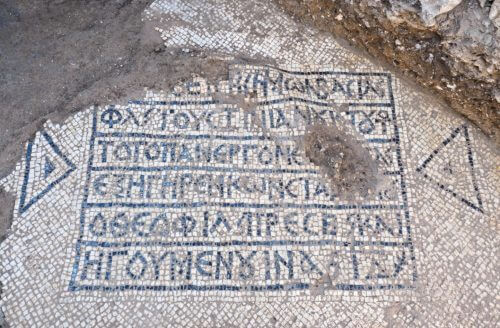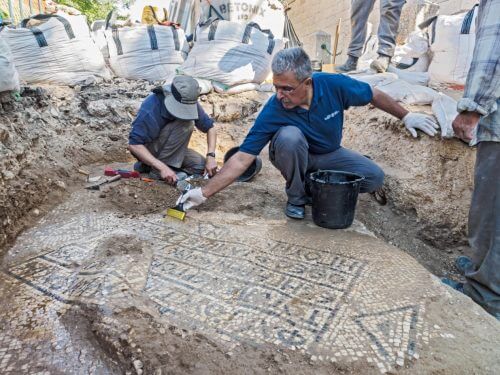The inscription, written in Greek, appeared on a mosaic that seems to have been used as the floor of a hostel for pilgrims, and it mentions the name of the Byzantine emperor Justinian

A fragment of a 1500-year-old mosaic, bearing an important inscription in Greek, was uncovered last June during works to lay a communication cable of the Partner company near the Nablus Gate in the Old City of Jerusalem.
The discovery of the find in its entirety surprised and excited the archaeologists. According to David Gelman, the director of the excavation on behalf of the Antiquities Authority: "The fact that the inscription survived, and along with it the historical story, is simply an archaeological miracle. The excavation in such a small area showed that the ancient remains that were there were severely damaged during the last decades as a result of the laying of modern infrastructure lines. At one point I was about to close the excavation, but suddenly, among the modern pipes and cables, the mosaic popped up. Amazingly, he was not hurt at all. Every archaeologist aspires to discover an inscription in his excavation, certainly when it is so well preserved, almost in its entirety."
Dr. Leah Di-Sagni, an expert on ancient Greek inscriptions at the Hebrew University of Jerusalem, deciphered the inscription:At the time of our most pious ruler Flavius Justinianus, The priest and abbot of the God-loving Constantine He also founded and erected this entire structure in the 14th year of the indication." According to Di-Sagni, "This is an inscription commemorating the foundation of the building by priest Constantine. The inscription mentions the Byzantine emperor Flavius Justinianus. It seems that the building itself was used as a hostel for pilgrims. According to the researcher, "Indication is an ancient method of counting years (for tax purposes). Based on historical sources, the mosaic can be dated to 550/51 AD."
According to Gelman, "The Nablus gate was used for thousands of years as the main northern entrance to the old city. Against this background, it should not be surprising that its surroundings are rich in archaeological finds. "During the Byzantine period, with the advent of Christianity, churches, monasteries and hostels for pilgrims were built in the areas north of the Nablus Gate, and the place became one of the most important and lively urban centers of the city."

The two figures mentioned in the inscription are well known from the ancient historical sources and the archaeological find. Emperor Flavius Justinianus is one of the most important rulers of the Byzantine period and was one of the colorful and charismatic rulers of antiquity. During his time, the Roman Empire reached its peak, and the process of its transformation into a Christian empire was completed. He founded in Jerusalem in 543 AD a huge church which was dedicated to Mary, the mother of Jesus, known by its name the Church of the Nea. It was the largest church built in Jerusalem and among the largest throughout the entire empire. The abbot of this well-known church was Constantine, whose name is also mentioned in an inscription now uncovered near the Gate of Nablus. Remains of this church were partially uncovered in 1970 in the Jewish quarter, and even then they aroused great interest among archaeologists and researchers of Jerusalem in Israel and around the world. This excavation accompanied the excavations of the Jewish Quarter that began immediately after the Six Day War.
According to Dr. De-Sagni, the inscription found at the Nablus Gate is very reminiscent of an inscription that was discovered in the basements of the Church of the Naia, and because of its importance it is currently displayed in the Israel Museum. In the inscription, the same officials are mentioned - the emperor Justinianus, and the priest Constantine. Di Sagni adds: "With the help of this inscription, we begin to understand the construction works of the Emperor Justinian in Jerusalem, and in particular the Church of the Nea. It's amazing to see the rare combination of the archaeological reality and the historical sources, which are intertwined and illuminate for us the past of Jerusalem."
The new-ancient inscription was copied from its place by the conservation experts of the Antiquities Authority and is being handled in the mosaics workshop of the Antiquities Authority in Jerusalem.

6 תגובות
https://he.wikipedia.org/wiki/%D7%94%D7%A8_%D7%94%D7%91%D7%99%D7%AA#.D7.94.D7.AA.D7.A7.D7.95.D7.A4.D7.94_.D7.94.D7.A6.D7.9C.D7.91.D7.A0.D7.99.D7.AA
1. Al-Aqsa Mosque was a crusader church of the Templars until the conquest of Jerusalem by Saladin.
2. The Christians received their religion from the Jews - the Byzantines are Romans who received Christianity during the time of Constantine which is 1600 years ago 600 years before the Islamic religion.
The address is long before they built the Al Aqsa Mosque
And of course before the Islamic religion was born.
Therefore every word I wrote is correct and legislated in the Dome of the Rock, and whoever writes nonsense is the Muslim keeper.
Again and again the troll Avi brings up the nonsense,
This time he wrote "Romans who received their monotheistic religion from the Jews 1600 years ago"
is that so ? No, no, since the acceptance of Christianity took place starting in the third century by the persecuted Romans
Throughout the empire, the one who made Christianity an official religion was Constantinos at the beginning of the fourth century,
Later the troll writes: "The Crusader Church which later became the Alaqsa Mosque".
And this is already a waste of time since the Alaqsa Mosque was built on an empty lot
which was part of the Har-Habit area,
It's a shame that the troll doesn't check facts before he writes nonsense.
For age
What is important is that this is another proof that can be presented to UNESCO that the Byzantines (Romans who received their monotheistic religion from the Jews 1600 years ago) were here before the Palestinians (who are descendants of Arabs who immigrated here during the Ottoman period and during the British Mandate and who received their religion from Muhammad only a thousand years ago).
This inscription is about 300 years before Muhammad was born and many years before the Crusader church was built which later became the Alaqsa Mosque.
But didn't you actually say what is written in the mosaic? Was it not possible to translate this and bring the text in Hebrew??
The title is misleading... this is not an ancient Greek inscription, it is a Byzantine inscription in Greek. The difference in the dating of the two versions reaches up to 800 years difference.